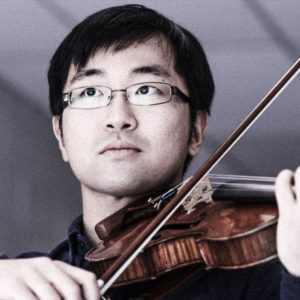Earl Kim & Isang Yun
Chi Young Song violin
Earl Kim composer
Isang Yun composer
On EARL KIM & ISANG YUN, violinist Chi Young Song presents complete works for solo violin by the titular composers, each of whom are of Korean heritage. Blurring the lines between Western musical heritage and traditional Korean music, each piece exhibits the crosscultural and borderless qualities of music. On 12 Caprices for Solo Violin, Chi Young tackles technical, intimate passages rooted in Western standards. The three works by Yun—written after his exile to Germany—make apt use of ornamental gestures, Korean folk music, and Taoist principles to harken back to the composer’s heritage.
Listen
Stream/Buy
Choose your platform
Track Listing & Credits
| # | Title | Composer | Performer | |
|---|---|---|---|---|
| 01 | 12 Caprices for Solo Violin: Motto - No. 1 | Earl Kim | Chi Young Song, violin | 1:18 |
| 02 | 12 Caprices for Solo Violin: No. 2 | Earl Kim | Chi Young Song, violin | 2:44 |
| 03 | 12 Caprices for Solo Violin: No. 3 | Earl Kim | Chi Young Song, violin | 1:25 |
| 04 | 12 Caprices for Solo Violin: No. 4 | Earl Kim | Chi Young Song, violin | 0:54 |
| 05 | 12 Caprices for Solo Violin: No. 5 | Earl Kim | Chi Young Song, violin | 1:30 |
| 06 | 12 Caprices for Solo Violin: No. 6 | Earl Kim | Chi Young Song, violin | 1:54 |
| 07 | 12 Caprices for Solo Violin: No. 7 | Earl Kim | Chi Young Song, violin | 2:15 |
| 08 | 12 Caprices for Solo Violin: No. 8 | Earl Kim | Chi Young Song, violin | 2:47 |
| 09 | 12 Caprices for Solo Violin: No. 9 | Earl Kim | Chi Young Song, violin | 2:55 |
| 10 | 12 Caprices for Solo Violin: No. 10 | Earl Kim | Chi Young Song, violin | 0:52 |
| 11 | 12 Caprices for Solo Violin: No. 11 | Earl Kim | Chi Young Song, violin | 0:56 |
| 12 | 12 Caprices for Solo Violin: No. 12 | Earl Kim | Chi Young Song, violin | 2:18 |
| 13 | Königliches Thema für Violine Solo | Isang Yun | Chi Young Song, violin | 10:05 |
| 14 | Li-Na im Garten 5 Stücke für Violine Solo: Die Hungrige Katze | Isang Yun | Chi Young Song, violin | 4:15 |
| 15 | Li-Na im Garten 5 Stücke für Violine Solo: Das Kaninchen | Isang Yun | Chi Young Song, violin | 5:36 |
| 16 | Li-Na im Garten 5 Stücke für Violine Solo: Das Eichhörnchen | Isang Yun | Chi Young Song, violin | 4:08 |
| 17 | Li-Na im Garten 5 Stücke für Violine Solo: Der Boxer Von Nebenan | Isang Yun | Chi Young Song, violin | 4:34 |
| 18 | Li-Na im Garten 5 Stücke für Violine Solo: Das Vögelchen | Isang Yun | Chi Young Song, violin | 4:07 |
| 19 | Kontraste Zwei Stücke für Violine Solo: I. | Isang Yun | Chi Young Song, violin | 11:59 |
| 20 | Kontraste Zwei Stücke für Violine Solo: II. | Isang Yun | Chi Young Song, violin | 9:58 |
Recorded April 03, 2021 at the Fowler Center in State University AR
Session Engineer & Producer Thomas Shuffield
Mastering Shaun Michaud
Executive Producer Bob Lord
Executive A&R Sam Renshaw
A&R Director Brandon MacNeil
A&R Morgan Santos
General Manager of Audio & Sessions Jan Košulič
Production Director Levi Brown
Audio Director Lucas Paquette
VP, Design & Marketing Brett Picknell
Art Director Ryan Harrison
Design Edward A. Fleming
Publicity Patrick Niland, Sara Warner
Artist Information

Chi Young Song
Chi Young Song (he/him/his), violinist and educator, has engaged with audiences throughout Asia, North America, and Europe. A passionate collaborator in both orchestral and chamber music, Chi Young is frequently invited to lead and perform with various ensembles and orchestras throughout the United States. As a recitalist, he is committed to putting into dialogue the works of marginalized and underrepresented composers within traditional repertoire.
Notes
This recording features the complete works for solo violin by two composers of Korean heritage. Born into a Korean family in Dinuba CA, Earl Kim (1920–1998) studied with one of the most influential composers of the 20th century, Arnold Schoenberg, and later taught at Princeton and Harvard Universities. Isang Yun (1917–1995) was born in Korea and studied composition in Japan, France, and Germany. After permanently relocating to Germany in 1969, Yun taught at the Hochschule für Musik, Theater und Medien in Hannover and the Universität der Künste in Berlin. In many aspects, these two men were quite similar. They both were prolific and celebrated composers and taught a number of successful students. Moreover, both were shaped by World War II and were quite politically active. Beyond these similarities however, their compositional languages cannot be more different.
Kim’s musical language is quintessentially European, although contemporaneous accounts pigeonholed his music as “oriental” and “Zen.” When Yun relocated to Germany in 1969, it was not by choice. Yun’s exile was in fact a political move by the then-Korean government to divert the national attention to a different scandal in the hopes of keeping the regime in power. Despite his resentment towards the Korean government and South Korea, Yun’s compositional voice is very much grounded in traditional Korean music and Korean culture.
— Chi Young Song

